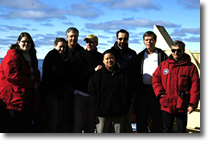IVARS: The End, and a Beginning

One immediate lesson we learned is that variations among years in the chemical and biological conditions of the Ross Sea are substantial. For example, nutrient removal varies not only in total uptake over the southern Ross Sea, but in the temporal progression of nutrient removal. Variations in nutrient uptake ratios were also observed. These affected, and were affected by, the composition of the phytoplankton assemblages in the surface layer. Understanding the controls of these changes will remain a major focus of the research team in the coming years. In short, what we knew for sure in the late 1990s is no longer a certainty.
We observed some amazing changes in the region. During our study period one of the most massive icebergs ever observed was grounded in our study area, and appears to have altered the physical circulation of the region, which in turn impacted the biological processes. How these changes in the phytoplankton in turn altered the food web and the regional biogeochemistry will be assessed in part in the coming months and years. We observed the "hundred year event" of ice cover in 2002, when ice was kept in the region by another massive iceberg (C-19), and which ultimately resulted in the loss of two moorings. We saw previously unreported secondary blooms in the region, and substantial spatial variations in oceanographic conditions that were poorly appreciated prior to the study. We fully expect many additional findings to result from the analysis of the data.
Our results have also pointed to other questions about the area. We have repeatedly observed large changes in space and time that occur over days and tens of kilometers (so-called mesoscale variations). We have observed that diatoms often rival haptophytes (a non-siliceous form of algae) in abundance and production, and we have seen large concentrations of pteropods, filter-feeding gastropods, that may be a poorly known but critical component of the food web.
So while the end of the fieldwork marks the end of a large effort, it also represents a beginning of data analysis and publication. Already one major publication has arisen from IVARS, with others submitted, and most likely another 10-15 publications will highlight the data collected. It is very unusual to have such repeated time-series data in such a southern location; indeed, it is a unique data set that has broad implications to the understanding of the most productive region in Antarctica.
So this final report is a thank you to all that had a part in the planning and execution—to those who ordered the supplies, arranged for travel, worked long hours, missed us when we were gone, and who paid the bills. It was great fun, hard work, and a challenge that none of us ever would have missed.

